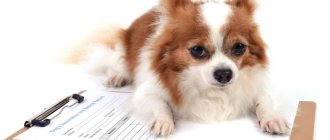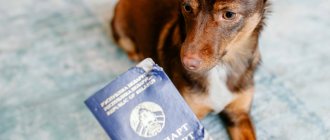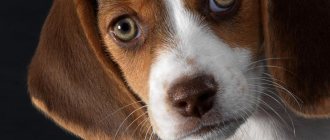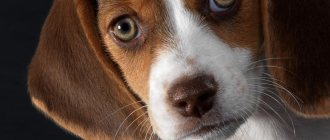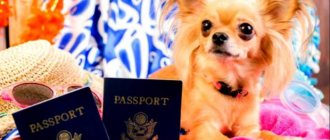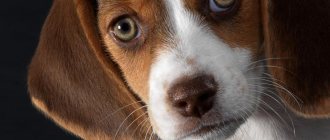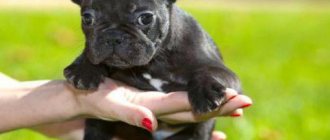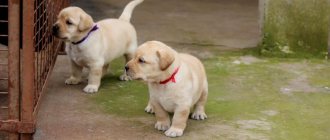The primary document in the RKF system is the puppy's certificate, which is issued by the breeder when handing over the puppy to the owner. !!! Attention, the metric must be issued by a breeder from Russia and he must work in the RKF system. The exchange of metrics for pedigree is carried out by federations - members of the RKF through their members - cynological organizations and nurseries. Cynological organizations (clubs) work directly with dog owners. To exchange the puppy's metric for a pedigree, the dog owner must contact any kennel club that is a member of one of the RKF federations, or his breeder. The kennel club of the RKF “Avesta” is such a club. If you lose your puppy's certificate, you need to contact the canine organization that issued the certificate for a duplicate.
Before paying the target fee, make sure that the breeder has registered the litter. This can be done on the RKF website using the link
You need to fill out the following form on the RKF website, take the data from the puppy’s metrics
What is PEDIGREE (EXTRACT FROM VERK). The RKF pedigree (extract from the RKF VERK) is a document confirming that your dog is purebred and that it is registered in the All-Russian Unified Pedigree Book of the RKF (VERK).
What is puppy metric and why is it needed?
The puppy certificate is the dog’s first document, which is issued by the kennel club during litter registration. The litter is activated within 45 days, during which a general litter card is drawn up, the puppies are branded, and each of them is given a puppy card, which is what is called a metric.
To issue a card, the breeder calls a club representative to inspect and describe the litter. The specialist examines and describes all puppies, and also identifies babies with signs of breeding. After which the dog handler and the breeder sign the Inspection Report. However, such a document can only be issued if the children already have a mark.
The metric is confirmation that the puppy was born as a result of a planned mating of specific sires. It is also necessary when purchasing a purebred dog, since otherwise its origin cannot be confirmed. In addition, the metric contains all the necessary data about the puppy, its parents and the breeder. The document must be certified by the signature of the person who issued it and have the club’s seal.
You should also know that the puppy card is only valid until the dog turns 15 months old. Until this age, a puppy gives the right to participate in exhibitions, competitions and other events for purebred dogs. Without it, the pet is not allowed to participate in such events, since its origin is not confirmed and the dog is not considered a purebred.
Another important factor is that only on the basis of the metrics can the dog’s pedigree be subsequently drawn up.
What documents do you need to have, besides the birth certificate, to obtain a pedigree?
The metric is the puppy’s birth certificate, this is its first document
To obtain an extract from the Verkhovna Rada, you must fill out an application. The form can be found on the RKF website.
For dog owners who purchased their pets from a breeder, it will be interesting to know that in addition to the metrics, they were required to be issued a veterinary passport, which is now being reported by the RKF.
As a result, you receive an extract from the VERK - the All-Russian Unified Pedigree Book. The main thing is not to delay time and do all this before the pet is 15 months old.
What information is included in the certificate?
The puppy card must contain the following information:
- Nickname.
- Breed.
- Date of Birth.
- Color.
- Details of the baby's parents.
- Brand number.
- Special marks - a column in which data on breeding marriage is entered.
- Breeder and owner details.
- Signature of the responsible person.
- Seal of the kennel club.
Read Obstacle course for dogs: 3 types of agility equipment, rules and best breeds
Who has the right to issue metrics?
Only the kennel club in which the female mother of the puppies was registered has the right to register. Also, a nursery that has undergone official registration may have the right to registration. In the second case, the document must be certified by the signature of the responsible person and the seal of the club.
A prerequisite for obtaining a card is the parents' permission to breed, and for this they must obtain official permission from the club. In a situation where the mating was carried out without the knowledge and permission of the club, the metric is not issued, since such mating is considered unscheduled and incorrect.
Where can you make puppies: RKF or SKOR
You can register puppies in the RKF - Russian Cynological Federation, which is a club recognized both in Russia and throughout the world. The federation office is located in Moscow.
A distinctive feature of this organization is a high degree of control over the quality of the puppies received, the rigor of the certification procedure, as well as strict rules for admission to mating.
In order to register a litter in this organization, you will have to go through a rather complicated procedure of certification and registration of the litter. But, if this is successful, then the dog will have the right to participate in all international exhibitions, as well as all events held in the territory of the former CIS. In addition, animals with documents from this organization are highly rated around the world and enjoy the trust of buyers.
SCOR is the union of cynological associations of Russia. Here the situation is simpler, and the registration procedure is smoother. But, at the same time, SCOR documents allow the dog to participate in events only in the territory of the former CIS. Such a document refers to IKU - the union of dog handlers of the former USSR.
An example can be given here. If a puppy was born to dogs without documents, but it meets all breed standards, then SKOR can issue documents for such a pet. The main condition is to conduct an appropriate examination and confirm compliance with all breed standards.
How to make a dog's pedigree
It is possible to make a pedigree for a dog only on the basis of documents confirming that the parents are in a certain community, the date of mating, documented by the club’s specialists, and the metrics issued by them. Registration of a pedigree consists of several stages.
First step: registration of the puppy's records
Metrica (puppy card) - a baby’s birth certificate. It is issued when the puppies are examined by the club's breeding experts within 45-90 days from the moment of birth. It indicates the date of birth, name and gender of the puppy, color, names of parents and their pedigrees, information about the owner. These metrics must match the mark located on the ear. The document contains information about the organization that issued the metric; it is certified by the seal and signature of the specialist from the canine organization who carried out the activation of the litter.
It is very important that the metric be filled out legibly in block letters.
The puppy metric consists of two parts. The upper part of the document remains in the RKF, where the breeder applies to formalize the pedigree. The lower part should be stored. If you lose your pedigree, she will help you obtain new documents.
According to the metric, you can take part in exhibitions until the dog reaches the age of 15 months. During the show, you can give the top part of the puppy card for pedigree registration, then the bottom part can be used to register participation in the event.
Second step: exchanging metrics for pedigree
The exchange of a puppy's metric for a pedigree is carried out at the central office of the RKF (Russian Cynological Federation) through local cynological organizations when the puppy reaches the age of 6 months and no later than 15 months. It is not at all necessary to belong to it in order to submit documents, but you will have to pay for the services.
You should fill out the puppy card very carefully. All printed letters must be written legibly so that the pedigree does not have to be reissued later. The metric must indicate the owner's initials and residential address with a zip code. Without it, puppy metrics will not be accepted for exchange.
Registration of a pedigree without metrics
There are situations when there is no metric for a puppy. Obtaining a pedigree for a puppy is also possible in this case. There should be a stamp on the pet’s ear, which indicates information that coincides with that recorded in the metric. Using the stamp number, the local canine organization will restore the documents and issue a duplicate document.
What documents are needed to register a litter?
In order to register a litter, you will need:
- An inspection report of puppies with the obligatory indication of the date of birth of the babies, the date of inspection, the presence or absence of rejected individuals or pets that were left for review.
- Application for litter registration. The address of the nursery is indicated here, as well as the signature of the owner.
- Litter cards of the puppies' parents.
- Direction for mating, about which a corresponding entry must be made in the general litter registration card.
Read How to take a dog abroad: 3 basic documents for hassle-free travel
Features of the design of a zero pedigree
If there is no mark and it is impossible to restore the puppy card, you can try to issue a so-called zero (register) pedigree. The process is lengthy and requires financial expenses.
It will be necessary to take part in at least 3 exhibitions, collect a package of relevant documents for them, then obtain the opinions of 3 independent experts in order to find out whether the animal meets the requirements of this breed. You can apply to the RKF for registration of a zero pedigree. It is important to know that it allows you to take part in exhibitions in the Russian Federation and receive diplomas, but the dog will not be able to receive the title of Champion.
Read Decoding the names of classes, ranks and ratings of dogs at exhibitions
Registration procedure
To get a puppy's certificate, you will have to go through the appropriate procedure. If you comply with all the requirements specified in the club’s conditions, then it will not take much time. The main condition is the availability of all documents and applications. In this case, the documents and application must be correctly drawn up and free of errors.
The first stage of registration is submitting an application for litter registration. To do this, you must have a document confirming that the mating was carried out with the permission of the club in which the mother of the puppies is registered. This document is called a mating permit.
The following condition is the presence of a certificate of breeding inspection of the parents before mating. Also, both parents must have all the necessary vaccinations, which is reflected in their veterinary records.
In addition, the owner of the dog must inform the club that he has no claims against the owners of the bitch and that all agreements have been respected.
The bitch must have a record card for all her litters.
It is also worth mentioning that only those children who have been examined and have not been rejected are allowed to receive a card.
If all of the above conditions are met, then the kennel club issues a puppy for each individual admitted for registration. At the same time, the breeder must apply an advisory mark to each pet at his own expense. This is done in a veterinary clinic. after which the stamp numbers are placed on the cards. They allow you to verify the authenticity of the document and also prevent the sale of another puppy using someone else’s card.
You can also subject your children to microchipping (optional), which must be indicated on the card.
Important! When receiving a metric, you should check it for errors directly at the club in order to avoid misunderstandings later.
What kind of dog shows are there?
Exhibitions are ranked as follows: - CAC rank - national competition; — CACIB rank – international competition. Among other things, exhibitions are divided into: - single-breed (exhibition for pets of the same breed); - for all breeds.
Breeding inspections are also possible, which are important for obtaining permission to breed.
Each participating dog must compete in its age category:
I. babies (3-6 m.); II. puppies (6-9 m.); III. juniors (9-15 m.); IV. adults (15 m.-8 y.); V. working class (pets with a certificate of completion of a training course); VI. champions (pets with champion certificates); VII. veteran class (pets over 8 years old). Each category is divided into females and males. Moreover, each breed appears at the exhibition separately from each other.
Exchange metrics for RKF pedigree
The exchange of metrics for a pedigree must be made no later than 15 months of age. If this deadline is missed, you will have to pay a fine.
Even if you do not plan to participate in exhibitions or competitions, it is still advisable to make a pedigree. After all, this is a certificate of the dog’s origin, which is an official document. Here you can find all the information about the pet’s ancestors in 3 generations, as well as the pedigree, which confirms that the dog is purebred.
Read the Rules for Carriage of Dogs and Puppies on Airplanes
There are several ways to exchange metrics for pedigree. The first and most reliable is to come to the RKF office and take your metric. With this option, the pedigree will be ready within a day, but you will have to pay a certain amount (around 3,000 rubles) for urgency. You can also arrange a non-urgent exchange here, it will cost less, about 1,500 rubles, but the processing will take about 2 weeks.
The second method will be convenient for those who do not live in Moscow and do not have the opportunity to visit the capital often. Such owners should contact the nearest kennel club with a corresponding application. In this case, the pedigree will be received within 2-3 months, and the price for the service will be set by the club itself. In some cases, the breeder can help with the exchange.
The third option is to find a person who is going to the RKF in the near future at a local dog breeders forum. In this case, the price and terms are negotiated individually.
It is also worth saying that to obtain a pedigree, the presence of the dog, any additional papers or participation in the exhibition is not required. In this case, you just need to provide a puppy and pay the membership fee.
When should you change the “puppy” to a pedigree?
It is recommended to change the metric from 6 months to 15 months, or when the dental pattern is clearly visible, it can be determined that there are no bite defects. Very young puppies may have unerupted teeth. Later it is also possible, but you will have to write an explanatory note at a minimum; other sanctions are possible. If the puppy was left for review according to the metric, then the “puppy” can be exchanged only after the specified period has expired with subsequent review. You will be allowed to change the metric only if the reason for which the review was ordered is eliminated. An example of this could be the correction (may change) of a malocclusion after changing teeth. Such a change will be considered successful.
Important! It is necessary to replace the “puppy” with a pedigree for the reason that according to the metric, mating is prohibited!
How to restore the metric if it was lost?
If the metric was lost, it can be restored. There are several ways to do this. The first way to restore the puppy's metric is to contact the breeder from whom the dog was purchased. The breeder retains the litter inspection certificate, according to which the puppy can be restored by contacting the canine organization that registered the puppies.
The second way is to directly contact the kennel club that carried out the activation of the litter. In this case, the document will be restored according to the number of the mark on the pet’s body.
In conclusion, it is worth saying that if exhibitions or matings are planned for the dog, then there is no point in buying a puppy without a metric. If the breeder has not activated the litter and has not received the documents, then it will not be possible to make them yourself; such a pet will live in the family only as a friend and companion.
